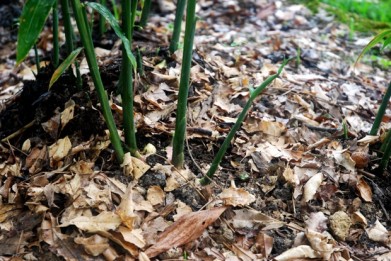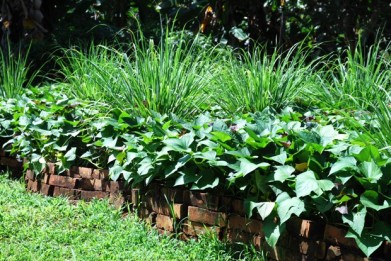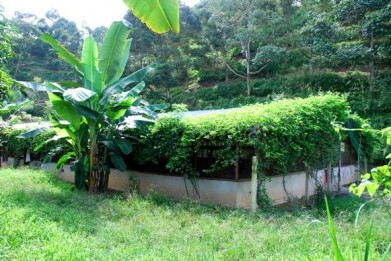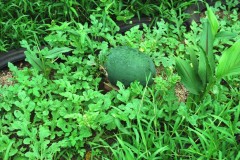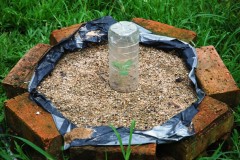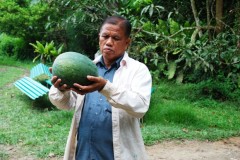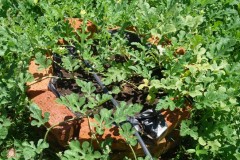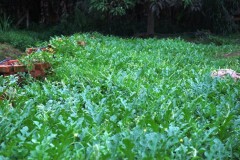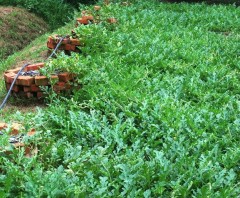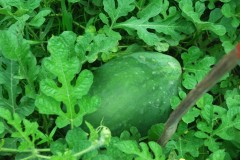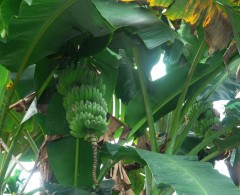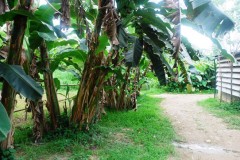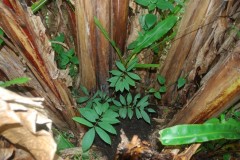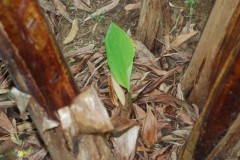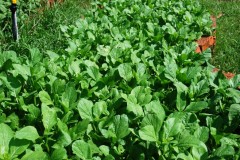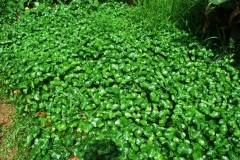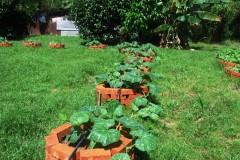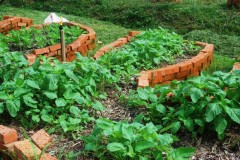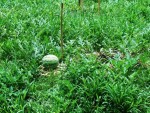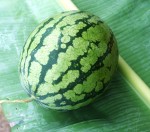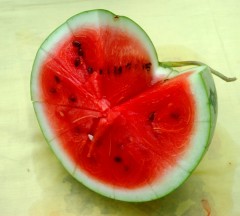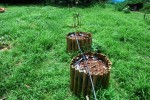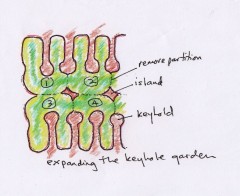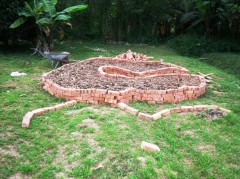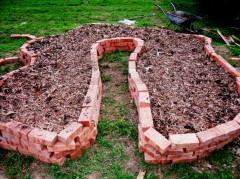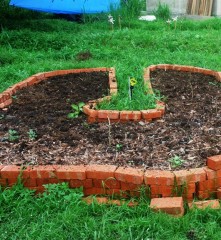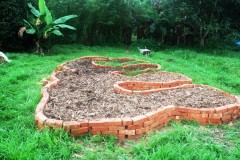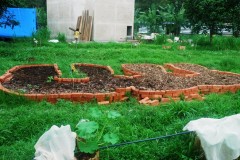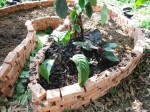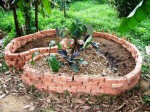Apr 13, 2011
Permaculture At The Farm II
Here are more examples of permaculture (permanent agriculture) at the farm:
Mulching to reduce water loss. Previously we advocated sheet mulching (to reduce weeds, etc ) with cardboard and other cellulose based material. DON'T DO IT! Termites love these heavy cellulose material. Mulching in humid Malaysia should be light to avoid termites and fungal problems. Leguminous cover crop as living mulch is a better idea.

Multi-crop and companion planting of gingers, chilies, sweet potatoes, water melon and passion fruits on raised beds. Permaculture is antithetical to mono-cropping (think oil palm, or think dragon fruit farms; organic or otherwise). On a small farm level, mono-cropping often leads to increasing dependence on chemicals and crops are often decimated suddenly by disease. The recent demise of many dragon fruit farms, both conventional and organic, is one example.
Serai or lemon grass on raised beds with sweet potato as living mulch and companion. Once the sweet potatoes are harvested, leguminous cover crop will be planted to revitalise the soil.
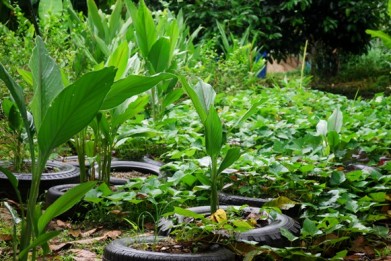
A low maintenance food garden grown entirely on used tires on low yield soggy, clayey soil. Practically no weeding is needed and monthly dressing of compost is all that's needed to produce sweet potatoes, curcuma mangga, lempoyang, kunyit and common ginger.
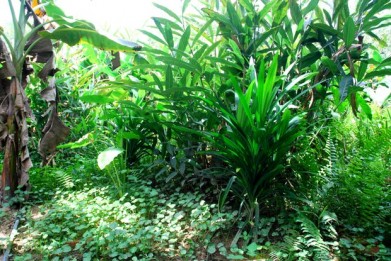
A 3000 sq ft food forest with very low maintenance, fed by a grey water treatment pond, producing taro, banana, papaya, pegaga, lengkuas, pandan, misai kucing, geranggau and other herbs. It provides a rich habitat for wild birds, eels, haruan, sepat, frogs, butterflies, insects, snakes, etc. It is one of our favorite spots in the farm. However, not everybody likes the overly 'friendly' snakes ( we counted 7 species so far ).
Under the traditional Asian chicken coop (on stilts), in-situ composting ( with the aid of farm-brewed IMOs ). This reduces human energy ( in having to remove the dung after every cycle). Removal of the composted material is done once every 8 months or so, and goes straight to the durian trees.
More examples of sun shading using plants - passionfruit, banana ( sematu, as it can reach 20 feet or more, high) and gliricidia septum.
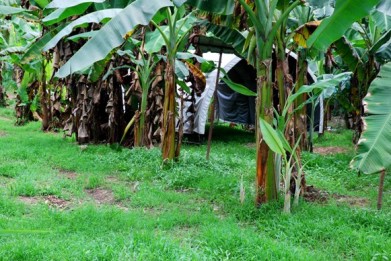
Integrating animal husbandry with fruits - here, free range chickens with bananas. There is no necessity to fertilise the fruit trees at all. Do not integrate durians with chickens.

Sematu is best - it has large leaves providing good shade, grows fast and is more hardy than 'improved' bananas like mas or berangan. The sematu above are young trees, barely three months old.

Free range chickens with mangosteen - here, hiding from the mid-day sun under the mangosteen fruit trees.
17:21 Posted in Permaculture | Permalink | Comments (2) | Tags: permaculture, free range chickens, sun shading, grey water treatment, integrated farming, permaculture examples, raised beds, companion planting, mulching, sheet mulching
Mar 11, 2011
Organic Watermelon At Fine
Officers from FAMA say we are the only organic watermelon producer in the country. They should know, since they visit almost all farms in Malaysia in efforts to upgrade farming methods to meet international marketing requirements.
We sell our watermelon at only one shop, Fine Organic Gallery at No. 103, Jalan Aminuddin Baki, Taman Tun Dr. Ismail, 60000 Kuala Lumpur.
The owner is Mr. Ng (picture below), and the phone number is 03 7727 6044
Here's his shop:
watermelon on raised beds made of old tires
We collect thrown plastic bottles to use to protect young watermelon seedlings
Proud farmer, Pak Cik Razaly, manager at the farm
Here are our previous posts on how we grow our watermelon:
16:36 Posted in Blog | Permalink | Comments (0) | Tags: fine organic gallery, organic watermelon, raised beds
Apr 30, 2010
Watermelon on Raised Beds
People don't grow watermelons on raised beds. That's what they told us.
Right, and that's why, we supposed, conventionally grown local watermelon have such a bad reputation for pesticides and fungicides!
It's logical, our climate is humid and wet, not really ideal for watermelon.
Further, local weeds will overwhelm the watermelon plant in days. So if we plant them on the ground then its logical that pests, fungal diseases and weeds must be kept at bay using a cocktail of chemicals - 3 in one!! :)
This is the raised bed we used:
Four bricks high, layer of compost at the bottom and filled to the brim with sand.
If you are planning to grow on a larger scale, do not use bricks, they are not really practical. Recycle discarded tires - just stack up two.
Lush watermelon plants fed farm-made compost tea once a week.
Heavy, succulent fruits on the way.
Things will go wrong, just don't throw out the baby with the bath water.
There are many possible reasons why the watermelon plant may not do well. Try to investigate, keep records, and modify and adapt.
One of the most common reasons is wrong seed. You will be surprised how often this mistake is made. Seeds from Japan, Taiwan, etc are not suited for growing naturally in our climate though they may thrive doing so in their home countries. We need to duplicate the conditions back home but that's not a route that sustainable farming should take.
11:05 Posted in Permaculture | Permalink | Comments (0) | Tags: raised beds, key hole garden, permaculture, watermelon
Apr 26, 2010
Permaculture is Bananas
Banana plants (it's a giant herb) can make their own food, retain water, and in our farm continuously produce 20 to 40 kg bunches without significant input.
Banana plants at our farm. Producing fruits year after year in the same spot without replanting.
Nowadays farmers grow rows and rows of tissue-cultured clones. These require high fertiliser and fungicide inputs.
At our farm, the banana epitomises permanent agriculture. We use our human intelligence to plant them at the right place - they like moisture and organic material. They will form a clump - trim the clump to about 4 to 5 plants so that they will produce reasonable sized bunches
A banana clump serves as a heat absorber. They cool down the earth due to their ability to retain water and reduce radiation of heat to buildings due to their shady leaves.
The centre of the clump hosts myriad microbes and earthworms due to its dark and moist conditions rich in organic matter. They quickly break down fallen leaves, dead trunks, etc into humus and then release these nutrients back to the clump as food. We only need to occasionally supplement with some compost and some chopped dead trunks.
We plant tuba or derris elliptica in the centre. The clump provides all the nutrients that the derris require. We don't even need to water the derris.
Derris in the clump :).
We have found that gingers do well in the clumps too. Gingers love organic matter and moisture. We are now planting ginger in all the clumps in the farm as a cash crop.
This temu kunci is growing at a faster rate than others planted outside the clump.
We, humans, have a choice - clear the land, plant rows and rows of clones and hybrids, feed them with synthetic nitrogen-based fertilisers and spray them with fungicides and due to the low contribution margin for such crops, go for 'volume', ie clear up more land to generate this 'volume';
Or go the permaculture way - use nature intelligently and work with nature to produce food for us for generations. We may not be rich in the short term, but we will be around for a far longer time. Multiple this idea by 100,000 farms and the landscape of the Earth's future changes!
16:44 Posted in Permaculture | Permalink | Comments (4) | Tags: permaculture, bananas, raised beds, compost, derris elliiptica, temu kunci, boesenbergia rotunda
Dec 10, 2009
Raised Beds - It is Cost Effective!
Raised beds incorporating design to maximise planting areas and reducing energy input was developed by the Permaculture movement. At DQ, we have added a small innovation, i.e. to make it expandable.
The expandable raised beds are now producing their third harvest:
This is bayam pasir again. We rotated the bed used.
And this is sawi bunga, a brassica chinensis var. It will be ready for harvesting cum thinning in a few days time when the flowers emerge.
There has been no purchased input and minimal on-farm produced inputs. When we replanted, we just top up with some compost, seed the beds and add mulch. We of course rotated beds. Once a week we spray some herbal extracts and our Teh Qi (compost tea) spray. That's about it. No weeding at all was necessary.
If you click on the pictures for a close-up, you can see minimal insect damage. And the plants are sweet and aromatic.
The office staff and their children came to help themselves to the vegetables and herbs, and to have a picnic at the farm.
The next bed that we will expand to, will be used to plant a herb, most probably basil as companion plant. In this way, we will reduce even further insect problems.
Here are some pictures of raised beds elsewhere in the farm:
Lush gotu kola or pegaga raised bed.
Healthy pumpkin plants under the mid-day sun on raised beds.
Watermelon plants on raised beds.
11:11 Posted in Permaculture | Permalink | Comments (0) | Tags: raised beds, key hole garden, permaculture, dark colored plants
Oct 28, 2009
Expanding Keyhole Raised Beds - Harvest Time
The Bayam Pasir (wild amaranth), a personal favourite is ready for harvest. And to be frank, I did not even visit the bed once since we sowed the seeds three weeks ago. Nobody did any weeding, the farm hand just turn on the sprinkler occasionally when the compost was dry to the 'poked-finger' and once a week sprayed some compost tea.
Note: Bayam Pasir draws unhealthy levels of nitrates from chemical NPK fertilisers. Always use low N compost. Avoid eating too much 'modern' hybrid vegetables grown conventionally. Always chose vegetables grown on compost such as Grace Cup, even though they may not be certified. Choose organic vegetables that are non-'modern' hybrid (heritage or heirloom) and slow growing, and grown on compost too. Talk to your farmer.
Avoid buying from 'organic' corporate farmers. They will use high NPK 'organic' fertilisers, high N demanding vegetable varieties (faster growing and larger), etc. Too much of these vegetables may cause imbalances in our bodies.
19:15 Posted in Permaculture | Permalink | Comments (0) | Tags: : keyhole beds, raised beds, organic vegetables, no-dig garden, permaculture
Sep 30, 2009
Organic Watermelons Anyone?
I love watermelons and just cannot find organic ones.
So we decided to grow our own.
Watermelons need sandy soil and plenty of water.
Watermelons on the way.
Almost ready for harvest. So far, no loss to insects and disease due to our sprays of Teh Qi and herbs.
Our first watermelon
Beautiful color and juicy; shared by Alternative Mom and her family with us.
Next, watermelon on raised beds:
If successful, we will go commercial as the market have very little and inconsistent supply of organic watermelons.
18:12 Posted in Blog | Permalink | Comments (0) | Tags: watermelons, raised beds, organic watermelon
Sep 24, 2009
Expanding Keyhole Raised Beds
One of the biggest headaches in organic vegetable farming in Malaysia is weeds. The weeds just grow too fast; napia, as an extreme example can reach 5 feet in 30 days. And do not forget lalang! Some conventional farmers here lay the entire planting area with plastic sheeting. Heck, some commercial organic farms do the same!
Weeding is back-breaking work especially for those new retirees who dream of establishing an organic farm: your back is going to give up before your first harvest.
Raised bed is one answer. For the new farmer, you can use an expandable raised bed design that we have developed to suit our local conditions and needs:
1. To increase your production capacity as your sales increases.
2. To reduce labour costs
3. To reduce weeding costs
4. To reduce dependence on machinery
5. To ensure long term soil fertility
6. To eliminate digging and tilling of the soil
Soil fertility has not been a problem with us using raised beds. Earthworm population remains high. And replanting by crop rotation and continuous adding of compost into the raised beds keeps production at optimum levels harvest after harvest.
This is the expandable raised bed design developed by us based on designs developed by permaculturists. The keyhole and curved edging allows for maximum utilisation of space, and it looks good compared to straight rows of beds.
(Click for close-up):
Bed One
Close up of bed One. You can reach half of the bed from within the keyhole and the other half from the outside edge of the raised bed.
How about that? After one month, still no weeds (well, if you can call those few pathetic sprouts, weeds). Notice how the top layer has changed to a darker color over the month. This is indicative of earthworm activity.
Adding Bed Two after one month
It is preferable to use stones or discarded bricks and concrete blocks to make your raised bed walls ( I make it a habit nowadays to stop at demolition and construction sites to pick up old bricks, etc). It is a one-time investment in labour and costs, and lasts forever as opposed to bamboo, timber, etc. Remember that in Malaysia, labour costs are a large component of your production cost and you do not want to incur labour costs repeatedly for the same thing.
(Click for close-up)
Another view: Beds One and Two, expanding laterally.
Now that we have demonstrated that even after 30 days there is no weed problems, we have started sowing Bed One with 3 different varieties of vegetables and in Bed Two, a wild amaranth (bayam pasir), a personal favourite. Go for heritage seeds when you first start out. They will do very well on compost and raised beds, have less disease and insect problems and will be very forgiving of your mistakes.
20:28 Posted in Permaculture | Permalink | Comments (2) | Tags: keyhole beds, raised beds, organic vegetables, no-dig garden, permaculture
Aug 21, 2009
A Spot Of Darkness
I have this thing about Darkness. So we decided to build a spot of darkness in a corner of the farm; a spot dedicated to dark colored plants. Plants with dark leaves, dark flowers, dark tubers.
The plants will be grown in a raised bed with a Permaculture key-hole design.
Lay out the design with the key-hole (used for walking when tending the garden)
Build up the wall; how high depends on how deep-rooted the plants are. (These are left-over clay bricks from the walit house).

Put in the planting material; here, dead leaves, some very old broken down chicken manure, some soil etc.
Then add in the compost and the plants.
Then mulch it.
Here we have only completed planting just one corner while we hunt for more dark plants. We planted some aroids from the jungle, such as this (haven't got the name yet. Click for close-up). :
And a Tacca Chantrieri from the jungle, which flower is black (Click on photo for close-up) :
Photo of the Tacca flower from here
Once the garden is matured, perhaps we can sip dark pu erh tea and savour it with a melancholic Stratovarius playing in the background.
12:04 Posted in Blog | Permalink | Comments (0) | Tags: raised beds, key hole garden, permaculture, dark colored plants.
Aug 17, 2009
Raised Beds – More Efficient?
We were quite happy with our 71kg of pumpkins from the trial 35ft x 10ft 'no-dig' patch.
From that first pilot, we have decided it may be more efficient all-round to grow pumpkins in raised-beds. Here's a couple of pictures of our pumpkin raised-bed patch:
Of course we are not advocating using clay bricks for the raised-beds. We happened to have some left over from the walit house.
You can also use bamboo as the next picture illustrates:
It will be interesting to know the overall cost-effectiveness of this 'raised-bed' method for growing pumpkins in terms of energy and effort used, production, etc.
15:43 Posted in Permaculture | Permalink | Comments (0) | Tags: raised beds, pumpkins, permaculture








